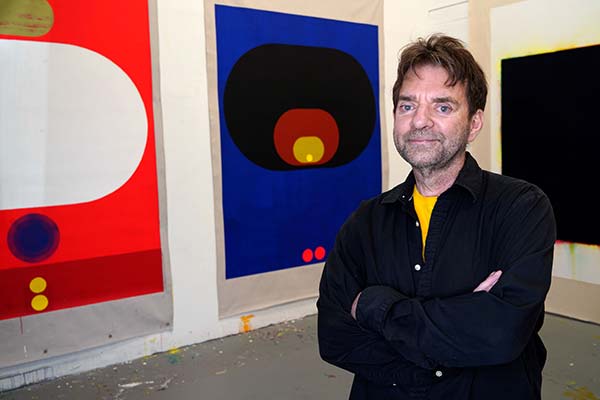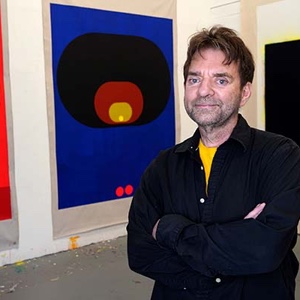
Tom Martinelli was born in New York City. His artwork has appeared in numerous solo and group exhibitions in New York, Santa Fe, Albuquerque, Boston, Chicago, Dallas, Atlanta, Los Angeles, and Pittsburgh, as well as internationally in Vienna, Austria, London, and Manchester, England. Martinelli, who now lives in New Mexico, has been a recipient of numerous grants and fellowships, including the Pollock-Krasner Foundation Award and a New York Foundation for the Arts grant in photography. His artwork has been reviewed in New York magazine, ARTnews, Modern Painters, New York Times, and Art + Auction. He holds an MFA from Hunter College and a BFA from the School of Visual Arts. His work appears in WTP Vol. VIII #6.
Interview with Tom Martinelli
By Jennifer Nelson, WTP Feature Writer
Nelson: Your signature as an artist seems very much the geometric. What initially led you to this focus in your work, and how does this precise mathematical instrument guide your practice?
Martinelli: I’ve worked with geometric shapes in some manner since I started painting. The paintings that are current and which I’ve made over the last few years are different from the more systematic and patterned paintings which preceded them. The forms I work with now are mostly non-idealized and non-measured geometry and often exhibit a certain amount of irregularity— bump and wobble—a kind of casual, handmade geometry. The shapes often have some mathematic reference in terms of their size and proportion, but the placement of shapes is determined intuitively. I’ve come to respond to them as if they have a kind of subtle gravitational or magnetic attraction/repulsion field around them, and in juxtaposition to their neighboring shapes.
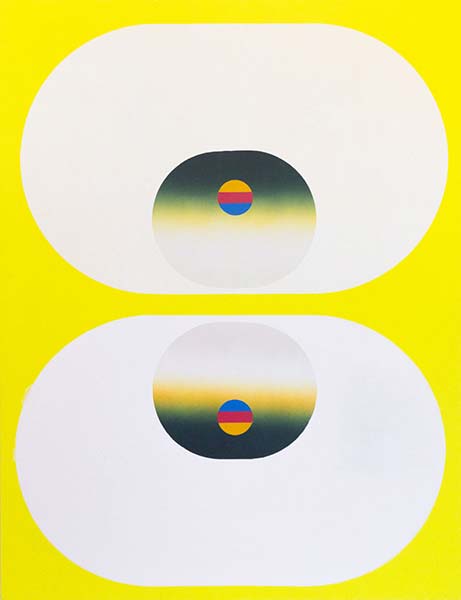
Courtesy of the artist
Nelson: What processes do you use to create such abstract paintings as “La Dolce Vita” and “Big Venus”?
Martinelli: I usually approach a painting with a basic idea for a composition. I’ll sometimes make small preparatory paintings on paper around a particular arrangement of shape or color. During the process the painting idea usually just pops. I get into a certain state of mind and an idea sparks. “La Dolce Vita” is on a 9-foot-tall canvas. It’s part of a group of works that I refer to as the “Orb paintings.” The painting started with a general idea and with no preliminary drawing in this case, but with a firm hit about the scale and an interest in working with an intense red ground. I knew upfront that I wanted the large white shape, which I thought had a strong and spacious presence. I’ve worked with similar shapes often, and so have developed a good sense of their potential weight, density, movement and personality, as well as the environment needed to hold them. But even with a game plan, after I put the first form on the canvas, I might change my mind about what’s next.
I usually work with stencils to paint forms. Stencils are shapes cut out of a material, in my case thin sheets of Mylar. Paint is applied through the stencil—similar to silk screening or the printing process. The stencil allows me mobility and responsiveness when moving a form around on the canvas. I also work with foam paint rollers, which can cover a broad area of canvas with a few decisive gestures.
With “Big Venus,” I had a compositional idea regarding the mirroring of top and bottom shapes. But again, I’m not seeking mathematical exactness, so all is approximate. It is more felt than measured. Sometimes I’ll make one shape a slightly different size than its partner shape, so they are intentionally not a perfect match. I think a viewer can sense such small inconsistencies and this provides a subtle entrée into the present moment by way of careful observation. As I worked on the painting, the relationships between the concentric circular shapes developed gradually. Each inner circle took on a different spatial quality. For example, the large white shapes are totally flat, and the smaller circular shapes within the white shapes have a light-to-dark gradient which implies a direction, or a potential curving or recession of space. The smallest inset circles then become a sequence of flat primary colors and facilitate a more schematic way of dividing and graduating a painted area. These different ways of depicting the spaces develop during the course of painting.
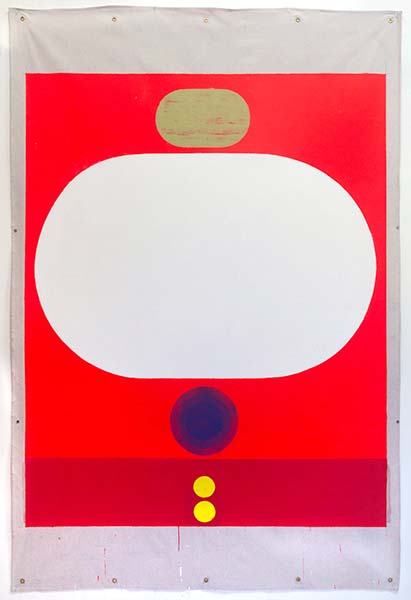
Courtesy of the artist
Nelson: Can you talk about how you came to your vertical stripe paintings, quite different from your current work?
Martinelli: The Vertical Stripe paintings were from the late ‘80s and early ‘90s. At the time, I was looking for a more structured way to paint than previously. When I was in school, I made paintings that were a hybrid of geometry and landscape, using a lot of brushstroke and gesture. I didn’t find it a fully satisfactory way of working as I never actually knew with certainty when a painting was done. I began making paintings that were more systematic and with a set number of procedural steps. When these steps were completed the painting was finished. The stripe paintings were among those paintings.
All the stripe paintings had the same pattern and game plan. The only elements that varied from painting to painting were the colors and the paint handling. After applying a ground color, I would work from the left or right edge, moving towards the center. The paint was very loose and watery and acted like a stain on the canvas by soaking in and running off, rather than sitting on the surface. After each step, I would flip the canvas upside down and continue the process with the directions now in reverse. This would, in effect, impact the actual direction of the paint flow. The process provided a back-and-forth balance and rhythm. Eventually the layers met in the center and the work was more or less complete. I tried to keep the paint layers thin enough so the viewer could see through the painting, but that didn’t always happen. I was using so much water to make the paint fluid that my studio was like a swamp. Paint would, at times, leak through the floor to the sweater factory below. Occasionally, they came upstairs and banged on my door. I wouldn’t always answer.
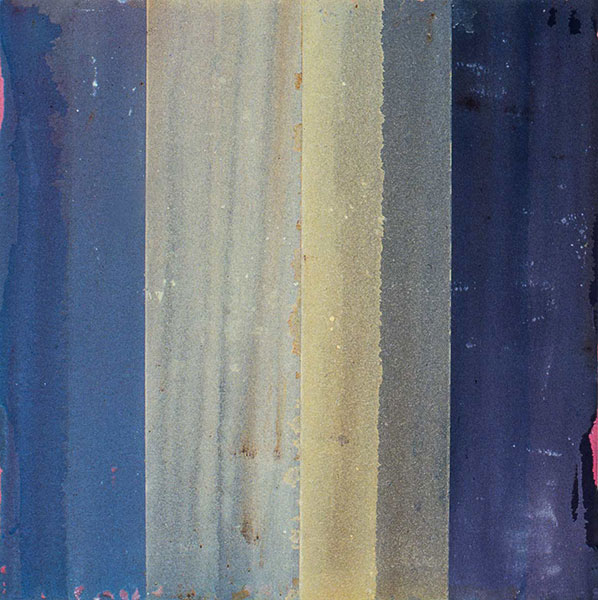
Courtesy of the artist
Nelson: What followed the stripe paintings?
Martinelli: Following the stripe paintings, I worked intensively for several years with patterned fields of circles, building up layers of overlapping circular shapes. I referred to these as “dot paintings.” Each layer was painted with transparent color, which, after all the transparencies overlapped, transformed into a color that became close to black. At the time I was very interested in field painting, influenced by painters such as Larry Poons, Morris Louis, and Barnett Newman, as well as Jasper Johns’ Crosshatch Paintings. I was also thinking of the halftone dots in newsprint and how a pattern of dots can create a field of space made of small independent parts or modules. Like the stripe paintings, the dot paintings were systematic, based on a plan of construction which established a certain number of steps. This was where I began my use of stencils, a tool I have relied upon ever since. Some of the codified aspects of these paintings—the overlapping of transparent layers and use of expansive spaces—have stayed with me through much of the work I’ve made over the years.
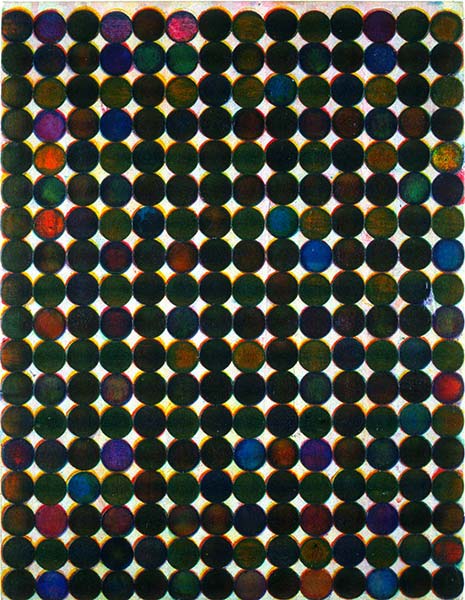
Private collection
Nelson: Your black-and-white works on paper are intriguing—in many, there’s a spontaneity that’s surprising, not only where you seem to break out from the geometric, but in your use of acrylics, lending them a fluidity. How did you come to this series?
Martinelli: While working on paper, I either explore a compositional idea or take a no limits free-for-all approach. Both are important methods of working. The work on paper can sometimes function as a kind of practice session for a painting. Sometimes I’m honing a compositional idea but I’m also getting a feel for the forms I’m working with and their relationship to each other. It can be a way of developing an understanding of the shapes I use. When I work with a range of forms over a period of time, they become like the words of a visual language.
Regarding the free-for-all approach, there is not much linear thought there, just quick responsive movement and a tactile, physical way of knowing things. Some of my best ideas come from working this way. There’s a time for the mind and a time for no-mind. No-mind, with the addition of touch and velocity, can materialize in beautiful and unusual ways. I put these works on my site because I value the role they play in telling a story about process, however nonlinear it may be. Acrylic on paper is particularly good for working this way. Also, working in black and white removes decision-making regarding color choices. Since I am slow and deliberate with making color choices black and white becomes a quicker way to realize certain ideas.
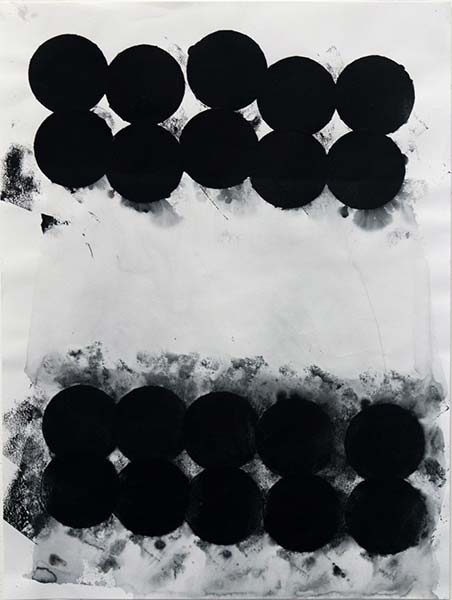
Collection of the artist
Nelson: Did growing up in Queens with a father who worked in offset printing impact your decision to become an artist, and if so, how?
Martinelli: Most of my interest in art was Grandpa-inspired. Grandpa Felix had a keen eye for creation and aesthetics. He was a savvy Northern Italian guy. If anyone moved me in the direction of art making, it was him. I did, though, spend a lot of time with my father in offset printing plants in Manhattan and grew to love the process. The hundreds of feet of mis-registered offset print leader coming off a printing press was fascinating as were the vague patches of color coalescing into an image.
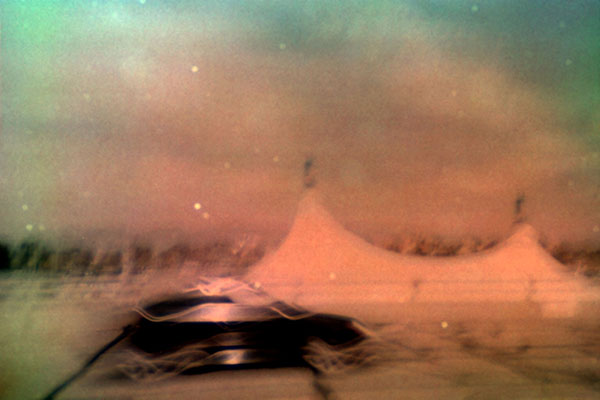
Courtesy of the artist
Nelson: What enticed you to branch out to photography, and can you talk about your varied subjects—some which seem to echo your fascination with the geometric, but others that resonate of something else entirely?
Martinelli: I took a trip to New Mexico in about 2002 and had a nice accident that got me working with cameras. I had been playing with cheap cameras, some plastic, as they often had quirks and distortions in how they captured images, which appealed to my painter’s sensibility. One extremely hot New Mexico day I inadvertently left a camera on the car dashboard. I didn’t realize it at the time, but the camera’s electronic innards got cooked and probably reduced to slag. The shutter opened, but I assumed the film was baked. In any case, I went ahead and developed the roll, and when it came back, I got something unexpected—distorted, blurry images that were fantastic to my painter’s eye. I totally loved them. The photo “Airport” is from that roll. This accident got me going on periodic bursts of photographic activity over the next few years.
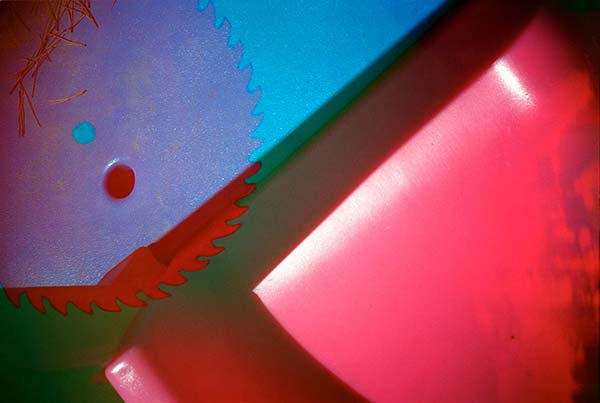
Courtesy of the artist
At one point, I was doing a lot of multiple exposure film photography by reloading 35mm color film into a camera several times. I kept a notebook and numbered the rolls. I’d carry around about 20 rolls that had passed through the camera already two, three, four times. Then I’d randomly pop one in the camera after consulting the notebook regarding the sequences I had been working with. Pass #1 might be clouds. Pass #2 color planes. Pass #3 shadows, and so forth. The system had a homegrown logic—a John Cage-like chance operation with no control as to how the images might be juxtaposed or how they might overlap each other. The process also reflected something about the painting procedures I’d been working with up until that time.
There were a number of other photographic periods. I accumulated a large catalogued library of image bits including cracks, circles, junctures, Jesuses, blurs, light leaks, and food. I’d then assemble them into multi-panel compositions, sometimes based on a theme, sometimes on a throwing-the-I-Ching type of process. Really though, I’ve never thought of myself as having any fixed identity when I work with a camera. It’s primarily a tool for open exploration. I think of myself mostly as a painter with a camera.
Nelson: How do you see your artwork evolving in the future?
Martinelli: I’m not very good at predicting the future. As far as my work goes, I think (and hope) it will continue to manifest. But as far as a direction forward, I never really feel like I’m done with the past, so I’ll likely continue to revisit past work, as has been my tendency. My interests seem to spiral back and forth in time—so in some way aspects of the past might become part of the future, but hopefully deeper and richer.
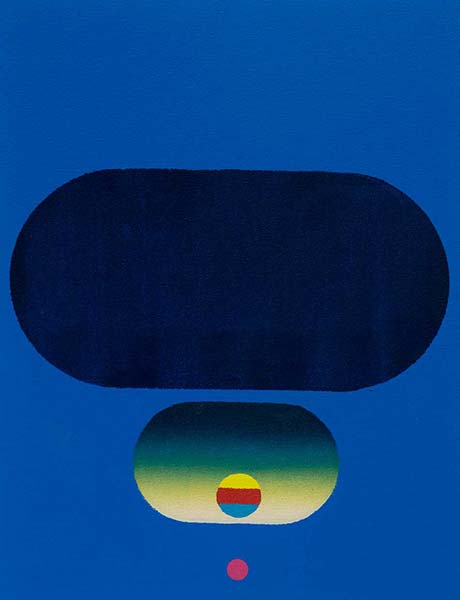
Courtesy of the artist
Copyright 2020 Woven Tale Press LLC. All Rights Reserved

